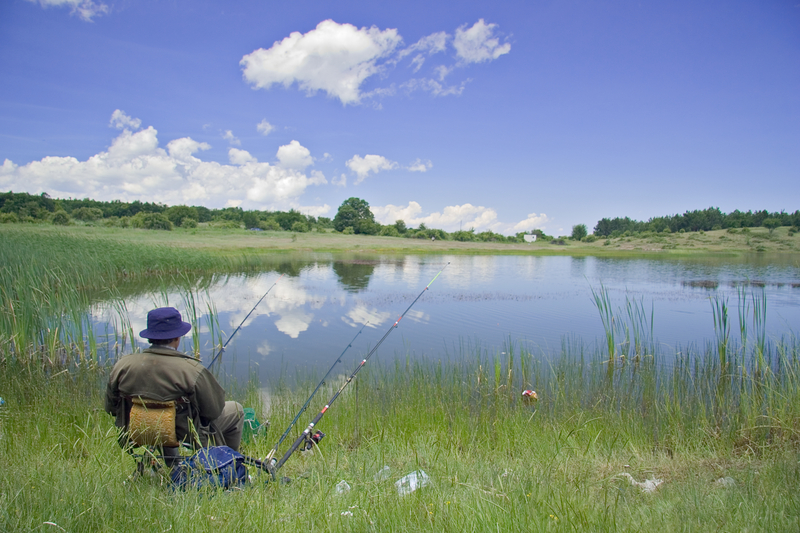
Two-thirds of Americans use lakes and rivers for fishing or other leisure activities. This helped estimate the implicit prices of surface water pollution. Credit: Ljupco|Dreamstime.com.
The annual gross domestic product (GDP) has summarized a country’s economic activities for almost a century. But the national revenue from all goods and services does not account for an important byproduct: the environmental damages embedded within those activities.
Economists began to develop methods to adjust the U.S. GDP for air pollution in the 2010s. A team of researchers including AAE professor Daniel Phaneuf was the first to extend those concepts to surface water pollution.
“Since the environment is an important part of human wellbeing, we should use a more holistic measure of economic activity that includes GDP-equivalent measures of environmental damages,” says Phaneuf. “We estimated the gross external damages (GED) from nutrient pollution—the biggest threat to U.S. surface water—as $53 billion in 2012.”
The researchers analyzed the impact of phosphorus and nitrogen pollution on lake recreation, housing, drinking water use, infant health and climate change. Major sources of these two pollutants are wastewater treatment plants—localized “point sources” that release effluent into natural waterways—as well as agricultural and urban runoff. These two non-point sources describe rain, snowmelt and irrigation water that picks up pollutants when it flows over fertilized cropland and livestock pasture or impervious urban surfaces before draining into watersheds.
The continental U.S. has 2,100 such drainage areas, roughly two-thirds the number of counties. A national hydrological database provides a digital representation of the interconnected network of 2.7 million lake and river segments within these 2,100 watersheds.
Phaneuf and colleagues combined that database with a hydrological model of the flow of water and pollutants through these segments, based on landscape features and 1999-2014 pollutant monitoring and precipitation data. The model helped estimate baseline loads of phosphorus and nitrogen from each source and simulate their yearly flow, resulting in average annual nutrient concentrations for each watershed.
Next, the researchers estimated economic damages from nutrient increases, or the social cost of water pollution. They assessed these implicit prices, measured in dollars per kilogram, separately for lake recreation, lakefront property values, drinking water treatment, infant health and climate change.
For example, increases in phosphorus reduce water clarity and may cause unsightly algae blooms. This reduces the number of people who visit a lake for swimming, fishing or boating. Previous surveys estimated the average value of an outdoor leisure day as $78 based on willingness to travel to recreation destinations. This number helped the team quantify the recreation damage of higher phosphorus levels. A similar strategy for housing relied on previous estimates for the decrease in lakeshore home values due to reduced water clarity.
“The number of affected people was much higher for recreation than housing since two-thirds of Americans pursue aquatic leisure activities, but only 3% live within 500 meters [0.3 miles] of a lake,” notes Phaneuf.

Drinking water treatment was the only economic damage caused by nitrogen rather than phosphorus pollution. The researchers identified 795 public water utilities that had to reduce nitrate levels to comply with the federal health standard between 2018 and 2022. (Excess nitrogen fertilizer becomes nitrate in water.) Thus, the implicit price of nitrogen pollution was based on the average cost of compliance, including capital, labor, energy and chemicals. The affected people were customers of the 795 utilities—a small fraction of the nation’s 11,000 public utilities that use surface water sources.
The impact of nutrient pollution on infant health relied on a study that linked low birth weight to the exposure of pregnant women to microcystin, a toxin produced by blue-green algae blooms. Low birth weight predicts chronic health conditions later in life and is a well-known indicator of local population health.
In contrast to localized damages for recreation, housing, drinking water and infant health, climate change damages are global. Higher phosphorus levels in aquatic ecosystems increase emissions of methane, a more potent greenhouse gas than carbon dioxide. Thus, the implicit price was based on the social cost of methane, which captures the human impact of heat-related diseases and deaths.
To obtain the total GED of $53 billion, the researchers multiplied implicit prices by nutrient loads and summed these values across the five damage categories. Because of the large role of population size, recreation accounted for 88% of GED, followed by climate change, housing, infant health and drinking water use.
“We also found that 20% of watersheds were responsible for 80% of damages, a surprising result that highlights the importance of downstream effects,” says Phaneuf. Damages can affect places far from pollution sources due to human travel—driving far to fish an attractive lake, for example—and due to hydrological connections between distant waterbodies.
The spatial distribution of GED identified priority regions for mitigation efforts. Rain gardens and parking lots with better drainage are examples of green infrastructure tools for reducing urban runoff. Areas with large agricultural runoff damages would benefit from targeted policies, such as financial incentives for farmers to improve manure management, add grass buffers or use cover crops. Managed grazing on farm pastures and removing phosphorus-rich lake sediment also help improve water quality.
The study confirmed the importance of such efforts: Nutrient loads from agriculture were three times higher than those from sewage treatment plants, contributing 65% and 21% of all loads. However, wastewater treatment accounted for 47% and agriculture for 38% of GED. The reason was that many agricultural emissions occurred in rural areas with fewer residents while most treatment plants were located near densely populated urban areas.
“The difference in GED from those two sources was one of our most striking findings,” says Phaneuf. “Although upgrading wastewater treatment methods can be expensive, the benefits may also be large.”